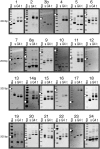Cell-to-cell movement of plastids in plants
- PMID: 22308369
- PMCID: PMC3289365
- DOI: 10.1073/pnas.1114297109
Cell-to-cell movement of plastids in plants
Abstract
Our objective was to test whether or not plastids and mitochondria, the two DNA-containing organelles, move between cells in plants. As our experimental approach, we grafted two different species of tobacco, Nicotiana tabacum and Nicotiana sylvestris. Grafting triggers formation of new cell-to-cell contacts, creating an opportunity to detect cell-to-cell organelle movement between the genetically distinct plants. We initiated tissue culture from sliced graft junctions and selected for clonal lines in which gentamycin resistance encoded in the N. tabacum nucleus was combined with spectinomycin resistance encoded in N. sylvestris plastids. Here, we present evidence for cell-to-cell movement of the entire 161-kb plastid genome in these plants, most likely in intact plastids. We also found that the related mitochondria were absent, suggesting independent movement of the two DNA-containing organelles. Acquisition of plastids from neighboring cells provides a mechanism by which cells may be repopulated with functioning organelles. Our finding supports the universality of intercellular organelle trafficking and may enable development of future biotechnological applications.
Conflict of interest statement
The authors declare no conflict of interest.
Figures






Similar articles
-
Exceptional inheritance of plastids via pollen in Nicotiana sylvestris with no detectable paternal mitochondrial DNA in the progeny.Plant J. 2012 Oct;72(1):84-8. doi: 10.1111/j.1365-313X.2012.05057.x. Epub 2012 Jul 9. Plant J. 2012. PMID: 22612300
-
Transformation of the Plastid Genome in Tobacco: The Model System for Chloroplast Genome Engineering.Methods Mol Biol. 2021;2317:135-153. doi: 10.1007/978-1-0716-1472-3_6. Methods Mol Biol. 2021. PMID: 34028766
-
Engineering the plastid genome of Nicotiana sylvestris, a diploid model species for plastid genetics.Methods Mol Biol. 2011;701:37-50. doi: 10.1007/978-1-61737-957-4_2. Methods Mol Biol. 2011. PMID: 21181523
-
PLASTIDS AND MITOCHONDRIA: INHERITABLE SYSTEMS.Science. 1964 Aug 14;145(3633):890-7. doi: 10.1126/science.145.3635.890. Science. 1964. PMID: 14165309 Review.
-
Eukaryotic genome evolution: rearrangement and coevolution of compartmentalized genetic information.Philos Trans R Soc Lond B Biol Sci. 2003 Jan 29;358(1429):87-97; discussion 97. doi: 10.1098/rstb.2002.1177. Philos Trans R Soc Lond B Biol Sci. 2003. PMID: 12594919 Free PMC article. Review.
Cited by
-
New insights into cytomixis: specific cellular features and prevalence in higher plants.Planta. 2013 Sep;238(3):415-23. doi: 10.1007/s00425-013-1914-0. Epub 2013 Jun 18. Planta. 2013. PMID: 23775439 Review.
-
Divide and shape: an endosymbiont in action.Planta. 2013 Feb;237(2):381-7. doi: 10.1007/s00425-012-1739-2. Epub 2012 Aug 22. Planta. 2013. PMID: 22910876 Review.
-
Horizontal genome transfer by cell-to-cell travel of whole organelles.Sci Adv. 2021 Jan 1;7(1):eabd8215. doi: 10.1126/sciadv.abd8215. Print 2021 Jan. Sci Adv. 2021. PMID: 33523859 Free PMC article.
-
The biology of grafting and its applications in studying information exchange between plants.Nat Plants. 2025 May;11(5):955-966. doi: 10.1038/s41477-025-01982-2. Epub 2025 Apr 8. Nat Plants. 2025. PMID: 40200023 Review.
-
Two distinct plastid genome configurations and unprecedented intraspecies length variation in the accD coding region in Medicago truncatula.DNA Res. 2014 Aug;21(4):417-27. doi: 10.1093/dnares/dsu007. Epub 2014 Mar 17. DNA Res. 2014. PMID: 24644300 Free PMC article.
References
-
- Sugiyama Y, et al. The complete nucleotide sequence and multipartite organization of the tobacco mitochondrial genome: Comparative analysis of mitochondrial genomes in higher plants. Mol Genet Genomics. 2005;272:603–615. - PubMed
-
- Bock R, Timmis JN. Reconstructing evolution: Gene transfer from plastids to the nucleus. Bioessays. 2008;30:556–566. - PubMed
-
- Stegemann S, Bock R. Exchange of genetic material between cells in plant tissue grafts. Science. 2009;324:649–651. - PubMed
Publication types
MeSH terms
Associated data
- Actions
- Actions
LinkOut - more resources
Full Text Sources
Other Literature Sources
Molecular Biology Databases
Research Materials

